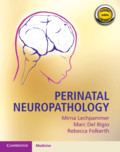Book contents
- Perinatal Neuropathology
- Perinatal Neuropathology
- Copyright page
- Contents
- Preface
- Acknowledgments
- Abbreviations
- Section I Techniques and Practical Considerations
- Approach to Autopsy of the Perinatal Nervous System
- Chapter 1 Clinical Considerations
- Chapter 2 Imaging
- Chapter 3 External Exam of the Fetus/Infant
- Chapter 4 Autopsy and Research Consent
- Ancillary Studies
- Prosection Techniques
- Tissue Selection
- Reporting
- Section 2 Human Nervous System Development
- Section 3 Stillbirth
- Section 4 Disruptions / Hypoxic-Ischemic Injury
- Section 5 Malformations
- Section 6 Perinatal Neurooncology
- Section 7 Spinal and Neuromuscular Disorders
- Section 8 Eye Disorders
- Section 9 Infections: In Utero Infections
- Section 10 Metabolic / Toxic Disorders: Storage Diseases
- Section 11 Forensic Neuropathology
- Appendix 1 Technical Considerations in Perinatal CNS
- Index
- References
Chapter 2 - Imaging
from Approach to Autopsy of the Perinatal Nervous System
Published online by Cambridge University Press: 07 August 2021
- Perinatal Neuropathology
- Perinatal Neuropathology
- Copyright page
- Contents
- Preface
- Acknowledgments
- Abbreviations
- Section I Techniques and Practical Considerations
- Approach to Autopsy of the Perinatal Nervous System
- Chapter 1 Clinical Considerations
- Chapter 2 Imaging
- Chapter 3 External Exam of the Fetus/Infant
- Chapter 4 Autopsy and Research Consent
- Ancillary Studies
- Prosection Techniques
- Tissue Selection
- Reporting
- Section 2 Human Nervous System Development
- Section 3 Stillbirth
- Section 4 Disruptions / Hypoxic-Ischemic Injury
- Section 5 Malformations
- Section 6 Perinatal Neurooncology
- Section 7 Spinal and Neuromuscular Disorders
- Section 8 Eye Disorders
- Section 9 Infections: In Utero Infections
- Section 10 Metabolic / Toxic Disorders: Storage Diseases
- Section 11 Forensic Neuropathology
- Appendix 1 Technical Considerations in Perinatal CNS
- Index
- References
Summary
As mentioned previously, review of any prenatal imaging (transabdominal ultrasonography, or maternal/fetal MR imaging) of fetal cases, or antemortem studies of liveborns, will assist greatly in the planning of the prosection. In addition, postmortem imaging (whether of the whole infant or of the isolated brain specimen) may be desirable in certain circumstances, assuming the consent for examination includes this as a diagnostic technique, and has the obvious advantage of lack of movement artifact
- Type
- Chapter
- Information
- Perinatal Neuropathology , pp. 3 - 4Publisher: Cambridge University PressPrint publication year: 2021

